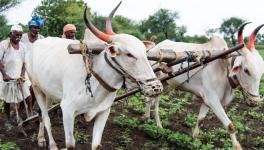MSP is Insurance Against Anarchy in Future: Economist Sukhpal Singh
Prime Minister Narendra Modi’s hope that his promise to repeal the three new farm laws will have the protesting farmers to promptly fold their tents and leave Delhi has been belied. The farmer unions have instead declared that they are not going to call off their one-year stir until the Union government gives a legal or statutory guarantee to provide the Minimum Support Price for all crops. Economists are bitterly divided—some say it will ruin the economy, others consider the Minimum Support Price as a measure to save farmers from devastation and death. What role does the Minimum Support Price have in agriculture? Why is it vital for farmers to be given a legal guarantee on it?
To answer these questions, NewsClick turned to Professor Sukhpal Singh. There cannot be a better person to explain the nuances of the Minimum Support Price. Prof Singh is Principal Economist (Agricultural Marketing) at Punjab Agricultural University, Ludhiana. He has carried out field surveys, and written academic papers and newspaper articles on Minimum Support Prices, rural distress and farm reforms. More significantly, he has been the head of the department of economics and sociology, and honorary director of the “Cost of Cultivation of Principal Crops”, a scheme sponsored by the Union government to fix Minimum Support Prices.
Let us begin with the history of the Minimum Support Price: When and why was it introduced?
Economic and political factors determined India’s food policy, of which the Minimum Support Price (MSP) is a crucial element. This policy emerged out of the 1943 Bengal Famine, which killed more than a million people. The famine was largely a result of the inadequate supply of foodgrains, prompting the British Indian government to appoint the Foodgrain Policy Committee, under the chairmanship of George Theodore, which emphasised the rationing of foodgrains.
Several researchers say the British also thought food shortages could create unrest and anarchy. They claim it was then that a prototype of the Green Revolution, which we saw fructify in the 1960s, was evolved.
What happened in post-Independence India?
Policymakers thought of creating a base for the Green Revolution. In 1964, the first commission for evolving a food pricing policy was constituted—the LK Jha Committee. It recommended the setting up of the Agricultural Prices Commission, which was a precursor to the existing Commission for Agricultural Costs and Prices (CACP). The Agricultural Prices Commission introduced the concepts of Minimum Support Price and Procurement Price (PP).
What is the difference between the MSP and the Procurement Price?
MSP is the minimum price the farmer must be paid for producing foodgrains. This price was supposed to cover the cost and give the farmer a certain percentage of profit.
Foodgrains would, however, be sold in the market at a particular price—or PP. In case there were no takers to buy foodgrains at PP, the government guaranteed that it would buy the produce at the minimum price—or MSP. People have forgotten that the Agricultural Prices Commission would announce two prices—not just MSP, but also PP. After the mid-1970s, the government stopped announcing PP, the reason why there is no memory of it today.
Why did the government stop announcing PP?
Since the government was not even lifting foodgrains at MSP, it made no sense for it to announce PP. The idea behind the MSP system was to provide remunerative prices to farmers for their crops, and sell these at reasonable prices to consumers. The Jha Committee had asked the Union government to establish the Food Corporation of India (FCI), which was done in 1965. The FCI was to procure foodgrains and keep a buffer stock. This was done to tide over food shortages. Likewise, the foodgrains were to be sold through the Public Distribution System (PDS). It was a universal public distribution system. Anyone who had a ration card could obtain foodgrains from ration shops, also known as fair price shops. These shops sold foodgrains at a price lower than the prevailing market rate.
Currently, the universal PDS has become targeted PDS, by excluding one-third of the population from this scheme. Actually, the government is trying to dismantle the PDS system in a phased manner.
What were the problems associated with implementing MSP?
One big problem has been that only small volume of the total agricultural produce is procured by the government at MSP. But there are geographical variations. In Punjab, Haryana and west Uttar Pradesh, the government procures almost all the foodgrains that is, wheat and paddy, at MSP.
In 2014, the government constituted the Shanta Kumar Committee, which said that since only 6% of the total agricultural produce is being procured at MSP, the government might as well stop lifting even this quantity. The Shanta Kumar Committee created a misconception that only 6% of farmers gain from MSP. This is incorrect. A far larger proportion of farmers produce the 6% of the total agricultural produce lifted by the government. Each and every farmer of Punjab, Haryana and west Uttar Pradesh along with large number of farmers from other states are the beneficiaries of the MSP system.
Since only wheat and rice are being largely procured at MSP, has this affected crop diversification?
Yes. Wheat and paddy are not risky crops, as, for instance, cotton is. [Cotton is susceptible to pests.] The production and marketing of both wheat and paddy are assured. These twin factors dissuade farmers from shifting to crops as or even more profitable than wheat and paddy. Monoculture farming has led to the depletion of the water table, reduced soil fertility and become a cause for pollution, largely because the stubble of wheat and paddy in the fields are burnt.
There is also the issue of calculating MSP, right?
It was sparked by what is known as the MS Swaminathan report. I must point out that Swaminathan headed the National Commission on Farmers, which submitted its last report in 2006. When people cite the MS Swaminathan report, an impression is created that it is an individual’s report. No, it is the Indian government’s own report, its own recommendations.
For the purpose of calculating the MSP, six concepts of cost—A1, A2; B1, B2; C1, C2—are used. This is a bit funny. A1, for instance, is the cost of production incurred by the farmer in cash. A2 includes A1 plus the rent paid for leased-in land. B1 is A1 plus the interest on the value of owned capital assets (excluding land). B2 is B1plus the rental value of land and the rent paid for leased-in land. C2 is B2 plus the imputed value of family labour. C2 represents the total cost of production for a crop.
Why do you find all this funny?
It is only in the agricultural sector you have different types of cost to figure out the actual cost of production. In no other sector of the economy, you will find a range from Cost A1 to Cost C2. There is only one method of computing cost—C2—or the total cost. That said, Swaminathan committee said the MSP should be C2, or total cost, plus 50% of it.
But then, in 2014, the Ramesh Chand Committee was established. This committee said certain factors of production had been underestimated while calculating MSP. The committee wanted the head of the farming household to be treated as a skilled worker than a manual labourer; the interest on the working capital to be calculated for the entire cropping season than half of it; the land rent taken into account to be the prevailing market rate than the ceiling rate fixed by the government—the latter is almost always lower than the former; and to also include the cost of post-harvesting operations like cleaning, grading, packaging and transportation costs.
The Ramesh Chand Committee suggested this ought to be the new method of calculating C2. The MSP, according to the committee, should be C2 plus 10%. This 10% was to offset the risks the farmer takes and also pay for his managerial skills.
Which of the two methods gives a higher MSP?
Swaminathan’s MSP is higher than Chand’s.
Which of the two methods is followed by the government to calculate the MSP?
Neither. The government calculates the MSP on the basis of A2 plus the cost of family labour. In other words, the government has chosen to ignore its own committees or commissions and their recommendations. This shows the government is mistreating the agricultural sector.
Why is MSP a big issue only in Punjab, Haryana and west Uttar Pradesh?
This is because MSP does not exist in large parts of the country. People do not know about MSP in many states as farmers do not have marketable surplus. In India, 86% of farmers operate on less than two hectares of land. On the one hand, 86% of farmers operate on less than two hectares of land. On the other hand, assured public procurement at MSP is prevailing in Punjab, Haryana and west Uttar Pradesh, where too it would have ended with the three farm laws.
Moreover, MSP is a big issue in Punjab, Haryana and west Uttar Pradesh due to a historical reason. When the Green Revolution model was concretised, it could only be implemented in the zone comprising Punjab, Haryana, west Uttar Pradesh, parts of Bihar and West Bengal. This was because the Green Revolution’s focus was on wheat and rice. It was in this zone that capital could be invested, for the Green Revolution technology, based on hybrid seeds, generous application of fertiliser and pesticide, required availability of abundant water. MSP was introduced as a price incentive to farmers in this zone. For instance, rice was never Punjab’s traditional crop. Punjab’s farmers switched to paddy because of MSP.
When did the MSP problem become aggravated?
Neo-liberalism post-1991 has created many problems for the developing countries. The Bali [in Indonesia] Ministerial Conference of the World Trade Organization in 2013 ordained that government support for crops should be withdrawn. The withdrawal of support was to be completed by 2017. The government, no doubt, kept increasing the MSP every year, but the rate of increase began to slow down. At the same time, the agriculture input costs continued to rise. In addition, the continuous privatisation of healthcare, education and energy increased the farming family’s economic burden.
All this decreased the income of farmers?
Not only that, they became heavily indebted. Since 2000, two farmers and an agricultural labourer, as my survey shows, commit suicide in Punjab every day. As per government report, 28 farmers end their lives daily in India. Farmers are also giving up on agriculture as a vocation.
On top of it, the Shanta Kumar Committee suggested that the government should discontinue procuring foodgrains, and that the Food Corporation of India was not required. The framing of the three laws, therefore, enhanced the fears that agriculture is due for privatisation, and the Agricultural Produce Market Committee (APMC) mandis, where MSP operates, would be dismantled.
The upshot of all this was that farmers thought the MSP system was to slowly come to an end. Since the maximum gains from MSP accrued to farmers in Punjab, Haryana and west Uttar Pradesh, it was only natural for these three to be rocked by social unrest. I must point out that only one-third of land is under assured irrigated farming in the country. This is precisely the area corporates covet. That said, the movement against the three farm laws has spread awareness about the importance of MSP across the country.
Farmers now demand that the government should give a legal or statutory guarantee for providing MSPs for all crops. What does this imply?
The government announces MSPs for 23 crops every year. These include seven cereals (paddy, wheat, maize, bajra, jowar, ragi and barley), five pulses (chana, arhar, moong, urad and masur), seven oilseeds (groundnut, soyabean, rapeseed-mustard, sesamum, sunflower, nigerseed and safflower) and four commercial crops (sugarcane, cotton, copra and raw jute.)
The government announces MSPs for all these crops, but it does not mean it buys the entire produce of each crop. In some areas, though, some produce of each crop are purchased by government agencies. They follow what is called targeted procurement.
What does targeted procurement mean?
For instance, the government can declare it needs 25 tons of a crop. It then enters the market and once the target is reached, it stops purchasing. However, even this helps farmers, for it enables them to “discover” the price.
What do you mean by discover?
Essentially, when a farmer enters the market he does not know at what price he should sell his produce. However, when the government enters the market, it becomes a benchmark for farmers. Assume the MSP for wheat is Rs. 2,000. Even those states where there is no wheat procurement, the MSP of Rs. 2,000 will help determine the price. Traders, at worst, will pay them, say, Rs. 100 or Rs. 200 less. This is why media outlets claiming that MSP does not help a large number of farmers are wrong. A large number of them are helped indirectly through this “price discovery” and “price realisation” mechanism.
If the demand of farmers to provide a legal guarantee for MSP is accepted, would it mean the government has to buy all produce brought to it at that minimum price?
Yes, it means that. But private traders would also be allowed to purchase foodgrains.
If the legal guarantee is given, would it mean traders will have to purchase crops at their MSPs?
Yes, traders cannot then buy below MSP.
Farmers say MSP should be for all crops. What does “all” mean?
There are two concepts here. Initially, the demand was to provide MSPs for the 23 crops I listed above. Since farmer representatives came from all parts of India to join the movement in Delhi, there arose a demand that MSP must be provided for all crops. Apart from the 23, we have horticulture products—vegetables and fruits—and livestock products such as meat, fish, eggs and dairy products.
Vegetables and fruits as well as livestock products are highly perishable. We do not have adequate storage capacity for these. However, the Kerala government recently announced MSP of C2 plus 20% for vegetables. Although its impact has not been studied, yet its announcement suggests MSP for vegetables can be provided.
Currently, India has a storage capacity of 88 million tons for foodgrains. In addition, 13 million tons are stored in the open, with tarpaulins covering them. The National Commission on Farmers recommended, in 2006, there should be an APMC mandi at every five-km radius. This means India should have had 42,000 APMC mandis.
How many mandis are currently there in India?
Just 7,000, or six times less than what it should have been. The government is, obviously, to blame for it.
Well, this requires huge investments. The government says it does not have money to spare.
Amidst fighting wars [against China in 1962 and against Pakistan in 1965], we created the infrastructure required to usher in the Green Revolution. The 1960s also saw agricultural universities surface. It is about how the Indian State perceives its priorities. Today, there is an undue emphasis on assisting the private sector, which is believed to be the panacea for all our ills. But do corporates invest their own funds in projects? They mostly borrow from banks, which possesses what is the money of people. If few private players like the Ambanis and Adanis can invest in agriculture, why cannot the government?
Public investment cannot just be seen as expenditure. It generates employment, raises income and drives the economy. Our industry is too mechanised to absorb people uprooted from rural India. It is, therefore, vital that more and more people are not displaced from agriculture. MSP is, therefore, not a government sop. It is bare minimum for saving the peasantry from devastation and destitution. It is an insurance against the anarchy of future.
At the heart of the demand for MSP is the debate whether the State or corporates should become the drivers of the economy?
Yes, it is about the State accepting its role in the economy and understanding its responsibility towards the people, particularly the poor.
Why is the mainstream media so opposed to MSP?
That is because the corporate media is the paw of global capitalists, who want to penetrate India’s agricultural sector.
(Ajaz Ashraf is an independent journalist.)
Get the latest reports & analysis with people's perspective on Protests, movements & deep analytical videos, discussions of the current affairs in your Telegram app. Subscribe to NewsClick's Telegram channel & get Real-Time updates on stories, as they get published on our website.
























